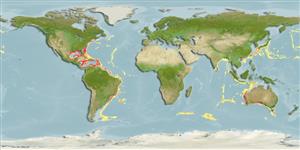Common names from other countries
Environment: milieu / climate zone / depth range / distribution range
Ecología
Batidemersal; rango de profundidad 310 - 2300 m (Ref. 3113), usually 365 - 730 m (Ref. 80749). Deep-water
Indo-West Pacific and Western Atlantic.
Length at first maturity / Tamaño / Peso / Age
Maturity: Lm 18.0 range ? - ? cm Max length : 50.0 cm TL macho / no sexado; (Ref. 99323)
Body depressed without distinct carapace. First thoracic segment fused with head. Sessible eyes; uniramous antennules with reduced exopodites.. First pair of thoracic appendages specialized as maxilliped; other thoracic appendages without exopodites. Shortened abdomen with segments often fused into caudal shield. Pleopods biramous, with flat rami serving as gills. Uropods and telson form fan-like fin, legs natatory.
Largest known isopod. Inhabits the upper and mid slopes of the continental shelf. Bycatch of baited traps (Ref. 80748). This species has mouthparts which are highly adapted to cut and ingest large pieces of food, a large and distensible gut for maximum food ingestion as well as the capacity to store large amounts of lipids in the hepatopancreas (Ref. 80748). Maximum depth range from Ref. 111151. Believed to be a scavenger because of its high incidence in bycatch of trap fisheries (e.g., golden crab, Chaceon fenneri, trap fishery in Northern Gulf of Mexico; see Ref. 80748) (Ref. 3113).
Oviposition in females preceded by parturial molt; functional form of oostegites obtained; females can grow between 1-3 cm BL in first parturial molt; 1 or more pre-parturial molts between the onset of ovarian maturity and first parturial molt.
Schotte, M., B.F. Kensley and S. Shilling. 1995. (Ref. 3113)
IUCN Red List Status (Ref. 130435)
CITES status (Ref. 108899)
Not Evaluated
Not Evaluated
Human uses
Pesquerías: sin interés
| FishSource |
Herramientas
Fuentes de Internet
Estimates based on models
Preferred temperature
(Ref.
115969): 6.4 - 14.4, mean 9.9 (based on 250 cells).
Resiliencia
Alto, población duplicada en un tiempo mínimo inferior a 15 meses (K=0.74).
Price category
Unknown.
